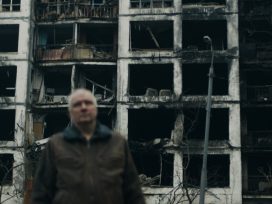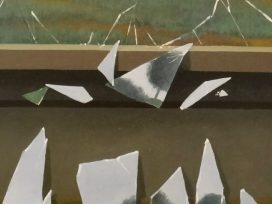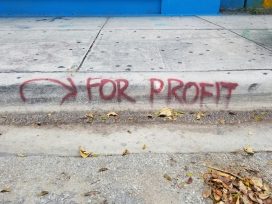Since Euromaidan and the first Russian invasion in 2014, Ukrainian filmmakers have been prolifically recording the impact of war on society. The result is an immensely powerful and varied body of work across genres and styles. A survey.
‘What power does art have in wartime?’ asks the poster for Iryna Tsilyk’s multiple award-winning début feature-length film, The Earth is as Blue as an Orange (2020). This is a central question for filmmaking in Ukraine, a country where an actor played a history teacher who miraculously became president, and then – like in a fairy tale – became president in real life. In Ukraine, the boundaries between reality and cinema are blurred; fiction becomes fact and vice versa. Filmmaking is a gesture of self-empowerment. Cinema, life and death are inextricably interwoven.
Among many other things, Tsilyk’s film was a tribute to a documentary produced almost a century earlier by a Ukrainian film studio. Dziga Vertov’s Man with a Movie Camera is still considered the apotheosis of self-reflexive meta-cinema, and Vertov the wunderkind of the Soviet avant-garde. Man with a Movie Camera is famous for being the first film to realize the dream of an empowered subject who takes history – and the writing of history – into their own hands; who sees themselves not only in the action, but in filmmaking itself, and in the act of watching films on the screen.
Dismissed from the Moscow Sovkino studio in 1927, Vertov was able to bring his experimental Möbius strip to the screen because the Odesa and Kyiv-based VUFKU film studio enjoyed a considerable degree of autonomy before 1929 and cultivated an atmosphere of freedom. Nevertheless, the categorisation of the classic as a masterpiece of Ukrainian rather than Russian cinema, as the Kyiv Dovzhenko Centre film archive in particular has been urging, continues to be derided by some, and even considered appropriation.1
Tsilyk positions her film within this tradition of self-empowerment and reflection through film. In The Earth is as Blue as an Orange, she makes this explicit in an improvised home cinema scene, in which a family of film enthusiasts (comprising single parent Ganna, her daughters Myroslava and Anastasija, and two young sons) are delighted by the inventiveness of Vertov’s silent movie and immediately start putting their own project together. Unlike the original, theirs is a ‘talkie’: a half-documentary, half-fictionalized re-enactment that observes, recalls, reconstructs, recreates and analyses what it was like in the family’s little house in the ‘red zone’ of eastern Ukraine in 2014, as they tried to continue living normally while shots rang out on the streets and grenades flew through the air:
1.1. – Dark screen, a sound: breaking glass, a cry: ‘Mama’, stamping feet. 1.2 – Cellar. Candles. The faces of children and their mother come into view. Mama soothes the children. – Close-up of candles? Yes, candles and fingers.
Tsilyk’s response to the question of the power of art in war owes much to Vertov. In her film, the younger generation reach for their cameras and in doing so reaffirm their will to document and reflect on historical events. For Tsilyk, filmmaking is a vital way of exploring the world and world-views, a kind of participation, a means not just of recording events but of inserting oneself into them. The character Myroslava’s first cinematographic work – the film in a film – is called Living By Rules and gets her through the entrance examination for Kyiv Film School. Rehearsals with the young actors (sometimes playing themselves) at a school in the Donbas also serve as training for real life: the students lie down flat when they hear a warning signal, decipher noises, plot routes on mobile phones, watch out for mines, make reports, and cooperate with the civil defence.
Tsilyk’s The Earth is as Blue as an Orange depicts the creativity and resilience with which an ordinary family uses the medium to make a documentary about the war and the rules of the game that inform their everyday lives and perceptions. It also reflects the very different experience of the daughter, a student in the capital, from that of the rest of the family, who remain in the east of the country. There are strong parallels between this separation and the prevailing attitude in Ukraine between 2014 and 2022, when there was still an invisible wall imagined between war and peace, a wall that the independent state’s emerging cinema has continually breached.
An existential relationship
Many other Ukrainian filmmakers across the generations and in all cinematic forms and subgenres have been investigating the relationship between the camera and the gun, between documentation and participation. Since the full-scale Russian invasion of Ukraine on 24 February 2022, this relationship has become existential. Actors who until recently were performing in front of the camera are sewing protective vests in Lviv and forming battalions in the Donbas – like Rodion, Katja, Slavik and Roman, characters in The Hamlet Syndrome (2022), an experimental and therapeutic documentary film by Elwira Niewiera and Piotr Rosołowski dealing with the young generation in Ukraine and their inner struggles over mobilization before 2022.
Directors such as Taras Tomenko are on stand-by and ready to fight. His documentary Boney Piles (2022) observes the socially and psychologically devastating consequences of the war in Donbas through the example of the fatherless Nastya and her friends in the small town of Torec’k. Ukraine’s most successful film producer, Vladimir Yatsenko, has joined the army while continuing to work on films – most recently Tsilyk’s feature Rock, Paper, Grenade (2022), about an Afghanistan veteran in the 1990s. Before that he produced Nariman Aliev’s Homeward (2019), a film about the consequences of the war for the Crimean Tartars, and Valentyn Vasyanovich’s two most recent features, Atlantis (2019) and Reflection (2021), which use explicit depictions of violence to address the war in Eastern Ukraine.2
Even better-known is the director Oleg Sentsov, whose life also oscillates between documentation and action. After making his debut feature Gamer in 2012, he joined the Euromaidan protest movement. In May 2014 Sentsov was arrested in Russian-annexed Crimea, charged with terrorism and sentenced to 20 years’ detention in a prison camp. Whilst in captivity, he survived a hunger strike and co-directed the film adaptation of his parable on totalitarianism, Numbers (dir. Akhtem Setablaev). Sentsov was released in September 2019 as part of an exchange of prisoners, and went on to complete his second feature film, Rhino, in 2021. Both films deal with the hardships of everyday life in Crimea in the 1990s, with Gamer presenting the perspective of an online gamer and Rhino the confession of a violent member of a criminal gang. Since 24 February 2022, Sentsov has been posting clips from the battle lines, where he is defending his country as a member of the Ukrainian army.
In the context of the war of aggression against the civilian population in Ukraine, filmmaking has long been a matter of life and death, even for those who have chosen ‘only’ the camera as their weapon. This is evident from the video clips of the #Babylon ’13 collective – a group of independent directors and camera operators that formed in the wake of the Revolution of Dignity in November 2013. The collective’s videos, which are distributed online, deal with the course of the war and the filmmakers’ involvement in it: they cook, provide transport and risk their lives to report on events. A central tool of these ‘partisans’ is the mobile phone. Without a trace of poeticization, fictionalization or dramatization, video fragments are turned into films.
One example is the diaristic War Note (2020), compiled by Roman Liubyi from clips filmed by soldiers and volunteers. The film deals with the nature of everyday life on the frontline in the separatist republics of Donetsk and Luhansk: improvised sleeping areas and kitchens, life in the trenches and discussions about Russian soldiers ignoring the ceasefire. It demonstrates how friendships can be ended in a moment by snipers, mines and grenades. Survival drills coexist with risk-taking; the volunteer spirit walks hand-in-hand with death.
Lithuanian-born Mantas Kvedaravičius, whose 2015 film Mariupolis traces the impact of the war on the day-to-day lives of the residents of Mariupol, was planning to film another documentary in the city in 2022 before he became the film world’s first high-profile victim of this war. In his 2011 film Barzakh, the director and anthropologist had already highlighted the consequences of Russia’s imperialist warmongering for local and regional populations in Chechnya. In early April 2022 he was murdered by Russian soldiers while shooting material for what would become his legacy, the film Mariupolis 2. In the reels, posthumously edited by Hanna Bilobrova and Dounia Sichov, destruction is ever-present, though not much of it is shown: a panorama of a street in the besieged, half-destroyed city – a courtyard with a Bunsen burner, a church that acts as a refuge for the now homeless population. The field of vision, and its scope for movement and expansion, are constrained by a continual sense of threat. Also striking is the heightened awareness of sound. Shots ring out in the background, detonations are heard. This is cinema as instructor in the military arts, as well as in in pragmatic philosophy.
The latter is evident in the thoughtful remarks of lone survivors who appear amid ruined buildings in Mariupolis 2, of the tram driver in the bombarded city in Mariupolis, of the parents of abducted Chechen children in Barzakh. Myroslava Tromfymčuk, the young camerawoman in Iryna Tsilyk’s The Earth is Blue as an Orange, states that ‘War is like a void’, to which her brother adds: ‘War is when people shoot at other people. And those people shoot back at the people who shot at them. When they start shooting, Mama wakes us up and we go into the hallway. And when they stop, we go back to bed.’ The heroes and heroines of documentary films about the war are all familiar with ‘300s’ and ‘200s’: casualties and deaths. Kvedaravičius, who was brought back to Lithuania in a coffin, was, in military jargon, ‘Cargo 200’.
Spectrum
Contemporary Ukrainian films about the war, which began with the annexation of Crimea in 2014, is evolving along three axes. First, there is the exploration of the relationship between civilian and military involvement; second, there are films that situate themselves in the space between documentary and feature; finally, there is the oscillation between dreams of peace, freedom and independence and the trauma inflicted by violence, torture, rape and death. There are overlaps in these approaches, just as they each refuse of clear dividing lines.
Ukrainian cinema is characterized by hybridity, just as reality. Films made about the war between 2014 and 2022 lay bare physical and emotional injury, suffering and pain, personal loss and social tragedy, inner conflict and diverging politics. Across a broad range of forms, they deal with social and ideological paradoxes. One-dimensional propaganda and blinkered mobilization have no place in these anthropological studies.
This is true even of the majority of blockbuster action films directly based on real-life events, including the first feature-length film about the war in eastern Ukraine, Cyborgs: Heroes Never Die of 2017. Directed by the Crimean Akhtem Seitablaev and with a screenplay by the playwright Natalia Vorozhbyt, the film includes not only numerous combat scenes featuring the defence of Donetsk airport by a battalion of volunteers, but also engages with a range of controversial social, political and ideological issues.
Cyborgs was awarded the ‘Golden Dzyga’ for best movie by the Ukrainian Film Academy in 2018 – an accolade seen in liberal circles as a sign of the resurgence of an (overly) patriotic movie industry. In fact, the film’s wide-ranging dialogue raises issues of national concern, from the banderovcy (Ukrainian nationalists reviled as neo-Nazis in Russian propaganda) to Chernobyl, and from Gogol’s linguistic and ethnic affiliations to his attitude towards the Ukrainian people. Soldiers from different regions, ethnicities and social strata argue about whether Ukraine is divided into East and West, liberal intellectuals and patriotic underdogs, pro-Europeans and pro-Russians, ‘compatriots’ and ‘traitors’. Cyborgs uncovers the war’s political and ideological underpinnings, depicting them as conflict zones in themselves. This is quite a contrast to another blockbuster drama, U311 Cherkasy (dir. Timur Yashchenko, 2019), which offers a bombastic, Hollywood-style depiction of the heroic stand taken by Ukrainian marines on the minesweeper Čerkasy, which was occupied by the Russian army in March 2014.
Natalia Vorozhbyt’s own feature début, Bad Roads (2020), plays out far from the military arena. Through four ambivalently and sparsely narrated episodes in, the film provides an indirect depiction of the consequences of the war: none of the characters has clean hands, the nerves of all are on edge, no-one trusts anyone, everyone is under suspicion, be they the school principal who has to go through a checkpoint but is unable to find his papers, the (secret) lovers of the soldiers (known as ‘Ukropy’ by the pro-Ukrainian side and ‘Sepy’ by the separatists), or the well-to-do woman who runs over a chicken and falls foul of a couple from the backwoods. The dialogue is almost documentary, with authentic-sounding speech and linguistic nuances from different social strata, generations and genders. Vorozhbyt’s writings and films are very popular with the Ukrainian public for their detailed portrayal of how the war eats away at everyday life.
Whether they deal directly with conflict, bring to light social differences or explore the emergence of a sense of community under the threat of a largely invisible enemy, these war films are a catalyst for nation building. This holds equally true in the sphere of non-fiction. Early documentaries about the protests and struggles in the Revolution of Dignity – All Things Ablaze (2014, Oleksandr Technynski, Alexsey Solodunov, Dimitry Stoykov), Euromaidan: Rough Cut (2014, Babylon’13) and Maidan (2014, Sergei Loznitsa) – were already depicting opposition without commentary, allowing their various protagonists to have their say. Four years later, The First Company, co-directed by Yaroslav Pilunsky, Yulia Shashkova and Yurij Gruzinov, offered a portrait of the men who went from the Maidan directly to the Donbas.
While the flashpoints of the Maidan and Donbas continue to be a popular subject, films engaging with operations on the Crimean peninsula are rare, due to Russian administration and censorship. However, there is one anonymous short, Annexation/Celebration: Who owns Crimea, which brings together fragmentary footage of the celebrations of Russian patriots in various towns on the peninsula from 2015 and 2016. It becomes clear that the filmmaker/cameraperson, amid crowds of pro-Russian revellers, is openly distancing themselves from the orchestrated patriotic and military spectacle.
Like The Earth is Blue as an Orange, two impressive smaller documentary films, Piotr Armianovski’s Mustard in the Gardens (2017) and Territory of Empty Windows (2020, Zoya Laktionova) draw attention to the impact of years of armed conflict on the civilian population. The ‘grey zone’ has developed a daily dynamic of its own. As depicted by Andrej Kurkov in his novel Grey Bees, routines are continually interrupted by grenade attacks and gun battles.
The polarization of the populations of eastern and southern Ukraine is given grotesque and absurd treatment in a number of films: Ukrainian Sheriffs (2015, Roman Bondarchuk); School #3 – a collection of interviews with teenagers (2017, Yelizaveta Smit); the short film Holiday (2017, Zhanna Maksymenko-Dovhych), which deals with specific disputes about Soviet heritage; and Mykolayiv: Chronicle of Protests, a portrait of the city (2019, Zhanna Maksymenko-Dovhych). The documentary genre makes clear the extent to which the history of the young Ukraine is a history of female power – not only with regard to filmmaking but also to the military.
The first major attempt at a coherent portrayal of the events of the war in Donbas, treating the political differences and personal losses within it, was made by Mariia and Anastasia Starozhytska. Their 2017 film The War of Chimeras, a portrayal of the struggle against the Russian separatist movements, is as informative as it is sensitive. The film follows a fighter in the ‘Black Corps’, showing him saying goodbye to friends, training in camp, travelling from the Maidan in Kyiv to Eastern Ukraine and encountering the local population. It depicts the ruined infrastructure of the de-occupied regions, the insecurity of the people, the survival strategies of women and children, but also wounding and death on the front. While the fighter is taken up with the events of the war in Ilovaisk, his girlfriend, who travels from the west to join him in Donetsk, attempts to understand what is going on in Ukrainians’ lives and how the war can be reconciled with what used to be known as everyday existence.
The protagonist of the film No Obvious Signs (2018) goes one step further – and with her the film’s director, Alina Gorlova, probably Ukraine’s best-known contemporary documentary maker. The début follows 46-year-old Major Oksana Yakubova, who trained in the Army for three years between 2014 and 2017 but tried to take some downtime and get out of the military. Gorlova created a sophisticated and nuanced portrait of an ill-treated individual and a shattered society. The soldier speaks openly about her symptoms of post-traumatic stress disorder and allows the director to be present for her therapy sessions.
Two aspects of the tragedy brought about by the war are immediately apparent: first, the way the experience of violence, in No Obvious Signs on the parade ground in Chuhuiv and in the Bakhmut mortuary, are etched into a person’s body and psyche, leaving indelible marks. Yakubova, who showed courage and valour on the battlefield, cannot travel on the Kyiv Metro without being reduced to panic. Second, there is the torment of guilt: those who have seen people die right next to them cannot come to terms with being alive themselves – they despair at their own powerlessness and confuse victims and perpetrators. The film lays bare what the doctors and the social security office cannot see – things that have ‘no obvious signs’.
Two other documentaries attempt something similar. One is Inner Wars, Masha Kondakova’s 2020 portrait of three female soldiers with very different experiences of the front (being corrupted, discriminated against, wounded, applauded etc.), but who all see their actions as having been necessary to defend the integrity and independence of their country. The other is This Rain Will Never Stop, Alina Gorlova’s second film. Once again, she takes a nuanced look at the war, but this time considers it in terms of global and geopolitical power games. The filmmaker follows Andriy Suleyman, a Kurdish Syrian with a Ukrainian mother who flees Syria for his mother’s east Ukrainian homeland in 2012. Suleyman works as a voluntary paramedic in Lysychansk and soon becomes a witness to the next armed conflict. With its striking imagery and subtle interweaving of narrative strands from different locations (Andriy’s brother lives in Germany, for example), the film is a powerful allegory of war and peace.
The feature film
Although Ukrainian documentary films are making a major contribution to social engagement with the war, it is mostly feature films that dominate at festivals and at the box office. Whether blockbusters or arthouse films, they are contributing to reflection on the impact of the war on Ukrainian society. In its various sub-genres and stylistic approaches, fictional film highlights the surreal temporality of the decade-long conflict. It is as though war has always been there, and that it seems to repeat itself. One this is certain: the conflict will not end any time soon. These films are simultaneously highly topical and universally relevant.
In Roman Bondarchuk’s début feature Volcano (2018), an OSCE military interpreter gets lost in the country’s southern steppe, reeling from one international misunderstanding to the next. While the context is specific, it is ultimately the general absurdity that shines through. Bondarchuk, who is also a producer and programme director of the Kyiv Docudays Festival, is one of the most important advocates for the Kyiv film community. Together with others, including the festival organizer and producer Darya Bassel, he has called for increased international visibility for Ukrainian cinema – and has opposed the ongoing hegemony of Russian cinema.
The central importance of communication is also the subject of Tera (2018), Nikon Romanchenko’s feature film début, in which, as in Volcano, the topic of war is discussed only in the margins. The film follows a woman who works in a confectionary factory in western Ukraine. It is only towards the end that the reason for her constant nervousness becomes apparent: her son is serving as a soldier. When he doesn’t answer his phone, she believes him to be dead and travels to the east of the country, searching, seeming to suspect, to know. Tera is a subtle study of the invisibility of the war, which continues to be intangible for large sections of the population, even though its violence continually impinges on everyday life.
Uncertainty is all-embracing; it also crosses borders, both within Ukraine and outside it. Maksym Nakonechnyi’s début Butterfly Vision (2022), a parallel to Gorlova’s No Obvious Signs, tells the story of a female soldier who has returned from war to the peace zone. But for the tortured, raped and pregnant 29-year-old Lilia, there is only a lack of understanding, discrimination and dysfunctionality. Neither her young husband – like Lilia, a veteran – nor her mother can help her reintegrate into civilian life. The war and the experience of violence are omnipresent, both physically and mentally.
When Russia invaded Ukraine for a second time in February 2022, four ‘big’ Ukrainian feature films of the previous five years that directly addressed the war had already been premiered and extensively discussed: Donbass, Atlantis, Reflection, and Klondike. Sergei Loznitsa’s Donbass (2018), a fictional remake of strange and disparate tales, included some authentic YouTube clips of the anarchic and bestial conduct of war in Donbas. Atlantis (2019), by Valenty Vasyanovych, is a dystopian sci-fi account set in 2025, portraying eastern Ukraine as an uninhabitable desert in which PTSD-afflicted ex-soldier Serhij is unable to gain a foothold until he gets a new job. The job is to exhume the war dead and give them a decent burial.
The brutality of Reflection, also directed by Vasyanovych, led to its being declared ‘exaggerated’ at its premiere in Venice in autumn 2021. The film focuses on a Ukrainian surgeon, again called Serhij, who is taken prisoner by Russian forces and tortured. Finally, Klondike (2022, Maryna Er Gorbach) is a fictionalised depiction of the shooting down of Malaysian Airlines flight MH17 in July 2014. Heroine Irka brings a daughter into the world amidst the war in eastern Ukraine – a world that is foundering before Irka’s eyes. Her house is first occupied and then bombed, her (pro-separatist) husband and her (pro-Ukrainian) brother are murdered by the occupiers, her previous existence is extinguished.
Ukraine’s painful struggle for independence is there to be witnessed on screen both by the Ukrainian ‘film-nation’ and international audiences. The films are more than the products of a culture industry: they enable their viewers to understand what is happening today. Such understanding is vital to the democratic world’s solidarity with the country. Even if, as Vasyanovych puts it, film has long been overtaken by the radicality and brutality of real life, let us look with hope for the next reel: ‘Where are you taking me?’ Irka asks her husband. ‘Somewhere where there’s no war.’ May their baby grow up in such a place.
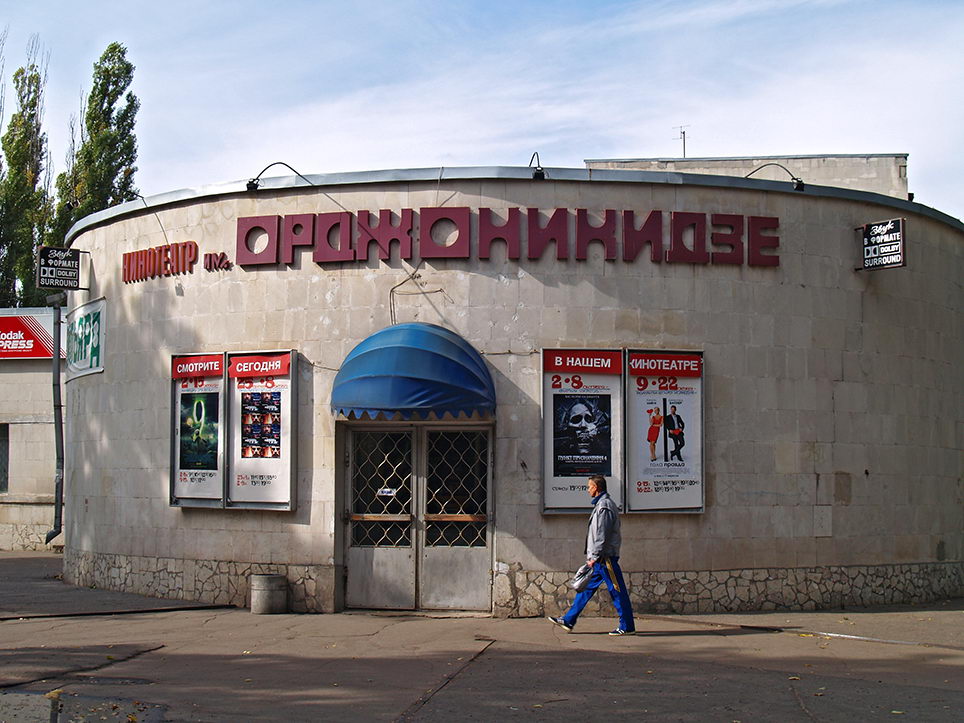
Cinema named after Sergo Ordzhonikidze. Photo by Мануйлова Наталия Яновна via Wikimedia Commons.
Filmography
Documentaries
All Things Ablaze (2014, Oleksandr Techynskyi, Aleksey Solodunov, Dmitry Stoykov)
Euromaidan. Rough Cut (2014, Babylon’13)
Maidan (2014, Sergei Loznitsa)
Ukrainian Sheriffs (2015, Roman Bondarchuk)
Mariupolis (2015, Mantas Kvedaravičius)
School #3 (2017, Yelizaveta Smit)
Mustard in the Gardens (2017, Piotr Armianovski), short
Holiday (2017, Zhanna Maksymenko-Dovhych), short
The War of Chimeras (2017, Mariia + Anastasia Starozhytska)
No Obvious Signs (2018, Alina Gorlova)
The First Company (2018, Yaroslav Pilunsky, Yulia Shashkova, Yuriy Gruzinov)
Mykolayiv. Chronicle of Protests (2019, Zhanna Maksymenko-Dovhych)
Territory of Empty Windows (2020, Zoya Laktionova), short
The Earth is Blue as an Orange (2020, Iryna Tsilyk)
Inner Wars (2020, Masha Kondakova)
This Rain Will Never Stop (2020, Alina Gorlova)
War Note (2020, Roman Liubyi)
Outside (2022, Olha Zhurba)
Mariupolis 2 (2022, Mantas Kvedaravičius, posthum)
The Hamlet Syndrome (2022, Elwira Niewiera & Piotr Rosołowski)
Iron Butterflies (2022, Roman Liubyi)
Feature films
Cyborgs: Heroes Never Die (2017, Akhtem Seitablaev)
Volcano (2018, Roman Bondarchuk)
Donbass (2018, Sergei Loznitsa)
Tera (2018, Nikon Romanchenko)
Homeward (2019, Nariman Aliev)
Atlantis (2019, Valentyn Vasyanovych)
U311 Cherkasy (2019, Timur Yashchenko)
Bad Roads (2020, Natalia Vorozhbyt)
Reflection (2021, Valentyn Vasyanovich)
Klondike (2022, Maryna Er Gorbach)
Butterfly Vision (2022, Maksym Nakonechnyi)
See I. Kozlenko, ‘Aloud about Ukrainian silents’, Ukrajins’ke nime. Ukrainian Re-Vision, Kyiv 2011, pp. 13–29; O. Radynsky, ‘Vertov and the surrealism’, ibid., pp. 48–91. On the role of the studio, see B.Y. Nebesio, ‘Competition from Ukraine: VUFKU and the Soviet Film Industry in the 1920s’, Historical Journal of Film, Radio, and Television, No. 2, 2009, pp. 159–180.
For Yatsenko‘s view of the war and the Ukrainian film community’s almost unanimous demand for the suspension of Russian films in the light of the war of aggression, see the interview ‘Art, War & Politics’, in Ukrainian Film (A Special Edition for Cannes Film Festival and Marché du Film 2022), pp. 15–18.
Published 28 April 2023
Original in German
Translated by
Sarah Rimmington
First published by Osteuropa 6–8/2022
Contributed by Osteuropa © Barbara Wurm / Osteuropa / Eurozine
PDF/PRINTPublished in
In collaboration with
In focal points
Newsletter
Subscribe to know what’s worth thinking about.
Related Articles
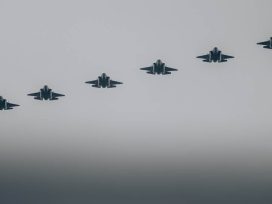
Russian drones entering Polish airspace, militarily seen as intensified provocation rather than open warfare, have nevertheless provoked costly responses – both from NATO’s air defence systems and civilian reactions to disinformation. A war correspondent’s view of what can be done technologically – for greater military efficiency and improved civil defence.

Imperial Russia saw the nation as the sea into which all the other Slavic cultures flowed. The idea persists today not only in Russia’s attitude towards its neighbourhood, but also in the way eastern Europe is studied in the West.

